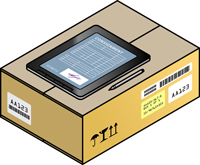By James N. Phillips Jr., DBA, PMP, CFCM, NCMA Fellow
 It may not be for everyone, but consignment purchasing has made a difference for some
It may not be for everyone, but consignment purchasing has made a difference for some
Consider this scenario: Dr. Jones, a neurosurgeon, is planning to perform a treatment of a brain aneurysm in the interventional radiology suite. She knows the outcome she intends, but not the particular items she will need, i.e., catheter, stent, coil, guide wire, etc. What does she do?
Consignment is not a new method. In fact Dr. Dean S. Ammer, arguably a father of the healthcare supply chain, stated in his 1983 book Purchasing and Materials Management for Healthcare Institutions, “This (consignment purchasing) has been common practice for extremely high-priced, high profit margin products such as pacemakers.”
Ammer goes on to say, “With consignment buying, the hospital takes physical possession of the inventory but does not legally buy it until the material is actually distributed to the nursing station.”
For this article, I will use the terms “consignment agreement” and “consignment purchasing” synonymously; however, in actuality, consignment purchasing refers to the method of purchasing and consignment agreement refers to the agreement between the vendor and the medical facility that makes consignment purchasing possible.
Traditionally, the practice was to requisition all items from the supply system so that all would be on hand if needed. This meant that the supply system had to maintain a stock of these items in the varying sizes, shapes, lengths, thicknesses, etc., to meet the most likely conditions of the operations. But there is a price for acquisition and storage of the items. Additionally, there is the additional burden of inventory and rotation of stock that will expire. The cost of maintaining stock is expensive when considering all potential items that may be reasonably considered.
A lean principle
Consignment is a just-in-time (JIT) system in which the medical facility retains specific stock items to meet its immediate need without incurring the cost of purchase UNTIL the stock is consumed. The aforementioned neurosurgeon could have the diversity of options available without incurring the cost caused by waste – certainly a LEAN principle. As Ammer said, “The case investment a hospital must make in inventory is also being increasing reduced by consignment purchasing.”
The positive elements (for the medical facility) of consignment agreements are:
- JIT access of items.
- Reduced inventory costs.
- Reduced impact on budget.
- Reduced impact on patient costs (as the cost of waste is passed to patient).
The negative elements (for the medical facility) of consignment agreements are:
- Secure storage space.
- Risk related to protection of consigned items, i.e., lost, damaged, stolen, etc.
- Management of consigned items (that is, establishing initial consignment, inventory and payment, and changes to initial consignment levels and items; as well as what supply management system will be used to manage the inventory levels and use.)
- The fact that consigned items not only add the burden of oversight and management of the inventory, but also of the consignment agreement and any related agreement for replenishment of stock from a particular vendor.
- The fact that multiple vendors require multiple consignment agreements, each of which must be managed separately, with its respective inventory separated from other vendors’ consigned items.
Things to consider
When entering a consignment agreement the medical facility needs to consider the following questions,
- Where will the stock be maintained?
- How will the stock be secured and protected?
- What are the stock items and inventory levels?
- When does title (ownership) transfer to the facility?
- Who will manage the inventory, and how (e.g., electronically in the facilities supply system, clipboard and paper)?
- When will stock be rotated?
- When will it be billed for consumed stock – weekly, monthly, quarterly?
- What level of access will the vendor representative have to spot check stock levels?
- When and how often should stock levels and diversity be reviewed to ensure optimum usage and stock mix?
- How will the records be maintained on implantable stock items, i.e., stents, pacemakers, hips, etc., to ensure proper tracking and tracing of devices?
- How will the records be maintained on medical consumables, such as catheters?
Caution
While consignment agreements offer great flexibility, supply chain executives should pay attention to this note of caution: There may arise instances where consigned inventory maintained at one facility will be needed at another facility, which may not even be in the same IDN. In such a case, the vendor’s representative may take from your inventory to backfill a need – perhaps an urgent need elsewhere. This action effectively makes your consigned items part of a network of consigned storage for the vendor. Such movement may occur without your knowledge. Sharing is not uncommon in a community with multiple hospitals. What is important is that if you have consigned items, you need to manage it.
Consigned items offer product diversity and convenience, which certainly are good things. Yet it does have its drawbacks as noted above. Entering into a consignment agreement is a way to manage costly inventory, while ensuring you have what you need and when you need it. It may not be for everyone, but for some, consignment purchasing has made the difference.
Editor’s note: Dr. James N. Phillips, Jr., PMP, CFCM, NCMA Fellow, has 25 years of experience as a contracting professional, 15 of them in healthcare. Prior to that, he was an X-ray technician for 12 years. He serves as volunteer mentor for the National Contract Management Association (NCMA) Contract Management Leadership Development Program. He may be reached at jnortonphillips@gmail.com
